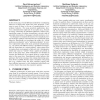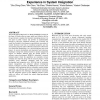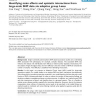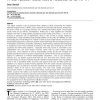203 search results - page 40 / 41 » Second-Order Risk Constraints |
ATAL
2006
Springer
13 years 9 months ago
2006
Springer
In the recent past, several different methods for coordinating behavior in multi-robot teams have been proposed. Common to most of them is the use of communication to coordinate b...
DGO
2008
13 years 6 months ago
2008
The Florida Public Hurricane Loss Model (FPHLM) developed in the State of Florida offers an open, public and effective tool for the government to regulate the insurance ratemaking...
BMCBI
2010
13 years 5 months ago
2010
Background: Single nucleotide polymorphism (SNP) based association studies aim at identifying SNPs associated with phenotypes, for example, complex diseases. The associated SNPs m...
ARTMED
2006
13 years 5 months ago
2006
Objective. In this article, we propose new methods to visualize and reason about spatiotemporal epidemiological data. Background. Efficient computerized reasoning about epidemics ...
JITECH
2007
13 years 5 months ago
2007
This paper contains a set of personal views relating to NHS Connecting for Health’s National Programme for IT (NPfIT), and in particular its Care Records Service, written from t...




